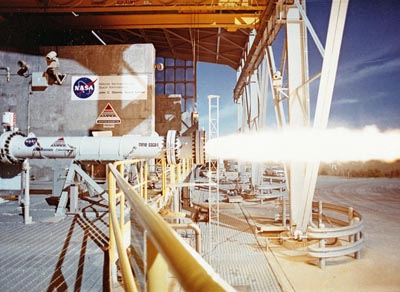hybrid-propellant rocket engine

A 10,000-pound-thrust hybrid rocket motor undergoes a test-firing in 1994 at Stennis Space Center's E-1 test facility.
A hybrid-propellant rocket engine is an engine that combines some of the advantages of both liquid- and solid-fueled rocket engines. The basic design of a hybrid consists of a combustion chamber tube, similar to that of ordinary solid-propellant rockets, packed with a solid chemical, usually the fuel. Above this tube is a tank containing a complementary reactive liquid chemical, usually the oxidizer. The two chemicals are hypergolic (self-igniting), and when the liquid chemical is injected into the combustion chamber containing the solid chemical, ignition occurs and thrust is produced. The engine can be throttled by varying the rate of liquid injected, and stopped and started by cutting off the liquid flow and later restarting it.
Other advantages of hybrid engines are that they provide higher energy than standard solid-propellant rockets, can be stored for long periods like solid-propellant rockets, and contain less than half the complex machinery, such as pumps and plumbing, of standard liquid-propellant engines. They are also less sensitive to damage to the solid fuel component than are standard solid propellant system. A disadvantage is that they generate less energy per unit mass of propellant than liquid-propellant engines and are more complex than standard solid-fueled engines. Although hybrid propellant rocket engines are still under development, versions with more than 100,000 kilograms of thrust have been demonstrated.


